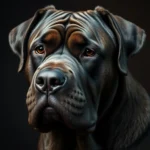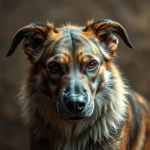
The Great Dane is often referred to as the gentle giant of the dog world, a title that captures both their impressive stature and their loving disposition. These magnificent dogs, known for their towering height and affectionate nature, have a rich history that goes beyond their modern-day role as family companions. To truly appreciate the Great Dane, it’s essential to delve into what Great Danes were bred for and how their original purposes have evolved over time.
Understanding a dog breed’s history is crucial not only for potential owners but also for anyone interested in canine behavior and training. Knowing the origins of Great Danes allows us to provide better care, training, and companionship tailored to their innate traits.
Historical Background of Great Danes
Origins
The history of the Great Dane can be traced back thousands of years, with its lineage possibly originating from ancient breeds like the Mastiffs and Greyhounds. These ancestry lines suggest that the Great Dane was developed primarily in Germany, where they were bred for specific purposes aligned with the needs of the time.
The Great Dane’s ancestors were formidable hunting dogs, trained to bring down large game. Their impressive stature was not just for show; it provided the strength necessary to tackle animals much larger than themselves, such as wild boars. This breed’s heritage reflects a combination of strength, agility, and a keen hunting instinct, qualities that have been refined over generations.
Evolution Over Time
As societies evolved, so did the role of Great Danes. Transitioning from fierce hunters to beloved companions, these dogs found their place within the homes of German nobility. They became symbols of status and elegance, often seen accompanying their owners on leisurely rides or protecting expansive estates. Their evolution from hunting dogs to cherished family members illustrates their adaptability and the deep bond they form with humans.
The cultural significance of Great Danes is evident in various historical accounts, where they played roles in royal households and were celebrated in art and literature. This transition marks a significant shift in what Great Danes were bred for, demonstrating their versatility and the enduring appeal they have maintained through the ages.
Purpose of Breeding Great Danes
Hunting and Guarding
Initially, the primary purpose of breeding Great Danes was to create a dog capable of hunting large game. Their size and strength made them ideal for this role, allowing them to pursue and capture boar and other formidable prey. The combination of speed, power, and a keen sense of smell made them invaluable hunting partners.
In addition to hunting, Great Danes were also bred to serve as guardians. Their imposing stature acted as a natural deterrent against intruders, making them excellent watchdogs. They were often tasked with protecting estates and property, ensuring the safety of their human families.
Companionship
As society progressed and the need for hunting dogs diminished, the role of the Great Dane shifted dramatically. People began to appreciate their gentle temperament and affectionate nature, leading to their rise as family pets. Great Danes became known for their loyalty and companionship, bringing joy to households around the world.
This transformation highlights the adaptability of the breed. While their physical attributes were initially developed for hunting and guarding, their temperament made them suitable for life as loving companions. This shift underscores the importance of understanding what Great Danes were bred for in terms of their behavior and needs as family dogs.
Show and Recognition
With the advent of dog shows in the late 19th century, Great Danes gained further recognition. Breeders began to focus on specific traits and characteristics, leading to the establishment of standardized breed guidelines. This emphasis on aesthetics and conformity to breed standards significantly impacted breeding practices.
The popularity of Great Danes in dog shows also contributed to their reputation as noble, elegant dogs. Their presence on the competitive circuit showcased not only their beauty but also their gentle nature, further solidifying their role as beloved family companions.
Physical Traits Linked to Purpose
Size and Strength
One of the most notable features of Great Danes is their impressive size. Adult Great Danes can stand anywhere from 28 to 34 inches tall at the shoulder, with some even taller. This immense stature is not merely for show; it serves practical purposes rooted in their history. The large size provides the strength necessary for hunting and guarding, making them formidable protectors.
Their muscular build, combined with a graceful demeanor, makes them both powerful and elegant. This duality is a testament to their breeding, as they were designed to be capable hunters while also embodying a noble presence.
Temperament
Despite their size, Great Danes are often characterized by their gentle and friendly temperament. Known for being affectionate and sociable, they thrive on human interaction and companionship. This gentle nature makes them especially suitable as family pets, as they form strong bonds with children and adults alike.
Understanding the temperament of Great Danes is crucial for prospective owners. Their friendly disposition means they generally get along well with other pets and children, making them an excellent choice for families seeking a loving and loyal companion.
Physical Features
Great Danes boast unique physical characteristics that were desirable for their original purposes. Their short, smooth coat comes in a variety of colors and patterns, including brindle, fawn, and harlequin. These features not only contribute to their aesthetic appeal but also play a role in their functionality. For instance, their coat requires minimal grooming, allowing them to adapt to various living conditions.
Additionally, their long necks and strong jaws were advantageous for hunting, enabling them to capture and hold onto prey effectively. These physical traits reflect the careful consideration that went into breeding Great Danes for specific tasks throughout history.
Modern Roles of Great Danes
Family Dogs
Today, Great Danes are primarily cherished as family dogs. Their affectionate nature, combined with their protective instincts, makes them ideal companions for families with children. Despite their large size, they are known for being gentle and patient, often forming strong bonds with the youngest members of the household.
Their playful demeanor and loyalty ensure that they are involved in family activities, from playing in the yard to snuggling on the couch. As family pets, Great Danes offer love, companionship, and a unique sense of security.
Therapy and Service Animals
Great Danes have also found a place in therapy and service roles. Their calm demeanor and gentle nature make them excellent therapy animals, providing comfort and support to individuals in hospitals, nursing homes, and schools. They possess an innate ability to connect with people, making them valuable companions for those in need of emotional support.
Additionally, some Great Danes are trained as service dogs, assisting individuals with disabilities. Their size can be advantageous in these roles, as they can perform tasks that require strength and stability. This evolution in purpose illustrates the versatility of the breed, showcasing their ability to adapt to modern needs.
Popularity in Pop Culture
The Great Dane’s size and charm have also made them popular in pop culture. They have appeared in various movies, television shows, and advertisements, often portrayed as lovable giants. For instance, the iconic character of Scooby-Doo is a Great Dane, further solidifying their status as endearing companions.
Social media has also played a role in popularizing Great Danes, with many owners sharing their experiences and showcasing their pets’ personalities online. This visibility has contributed to a growing appreciation for the breed, encouraging more people to consider adding a Great Dane to their family.
Caring for a Great Dane Today
Training Requirements
Training is a crucial aspect of caring for a Great Dane. Due to their size and strength, early socialization and obedience training are essential. Exposing them to various environments, people, and other animals helps them develop into well-rounded dogs. Positive reinforcement techniques work best, as Great Danes respond well to praise and rewards.
Owners should also establish consistent rules and boundaries to ensure that their Great Dane understands their place within the family structure. Regular training sessions not only strengthen the bond between dog and owner but also provide mental stimulation, which is vital for their overall well-being.
Health Considerations
While Great Danes are generally healthy dogs, they are prone to certain health issues that potential owners should be aware of. Common concerns include bloat, hip dysplasia, and heart problems. Regular veterinary check-ups and a proper diet can help mitigate these risks.
Bloat, in particular, is a serious condition that can affect Great Danes due to their deep chests. It’s crucial for owners to be knowledgeable about the symptoms and take preventive measures, such as feeding smaller, more frequent meals and avoiding vigorous exercise immediately after eating.
Exercise Needs
Maintaining a Great Dane’s health requires regular physical activity. Although they are large dogs, they don’t have high energy levels compared to smaller breeds. However, they still need daily walks and playtime to keep them mentally and physically stimulated.
Owners should aim for at least 30 to 60 minutes of exercise each day, incorporating both structured activities and playtime. Providing opportunities for socialization with other dogs and people can also enhance their overall quality of life.
Frequently Asked Questions (FAQs)
What is the lifespan of a Great Dane?
Great Danes typically have a lifespan of 7 to 10 years, which is shorter than many smaller breeds. Their size often contributes to a higher risk of certain health issues.
Are Great Danes good with children?
Yes, Great Danes are known for their gentle and patient nature, making them excellent companions for children. They often form strong bonds with kids and can be very protective.
How much space do Great Danes need?
While Great Danes are large dogs, they adapt well to various living situations. A home with a yard is ideal, but they can also thrive in apartments if given enough exercise and mental stimulation.
What is the typical diet for a Great Dane?
A balanced diet formulated for large breeds is essential for Great Danes. Owners should consult their veterinarian to determine the best feeding plan based on age, weight, and activity level.
Conclusion
Great Danes have a fascinating history that reflects their evolution from powerful hunters to cherished family companions. Understanding what Great Danes were bred for provides valuable insights into their behavior, needs, and care requirements. As gentle giants, they continue to capture hearts with their loyalty, affection, and unique personality.
Knowing the breed’s history enhances our ability to care for them properly, ensuring that they lead happy, healthy lives. Whether as family pets, therapy animals, or beloved characters in pop culture, Great Danes remain a remarkable breed worthy of admiration and love.









